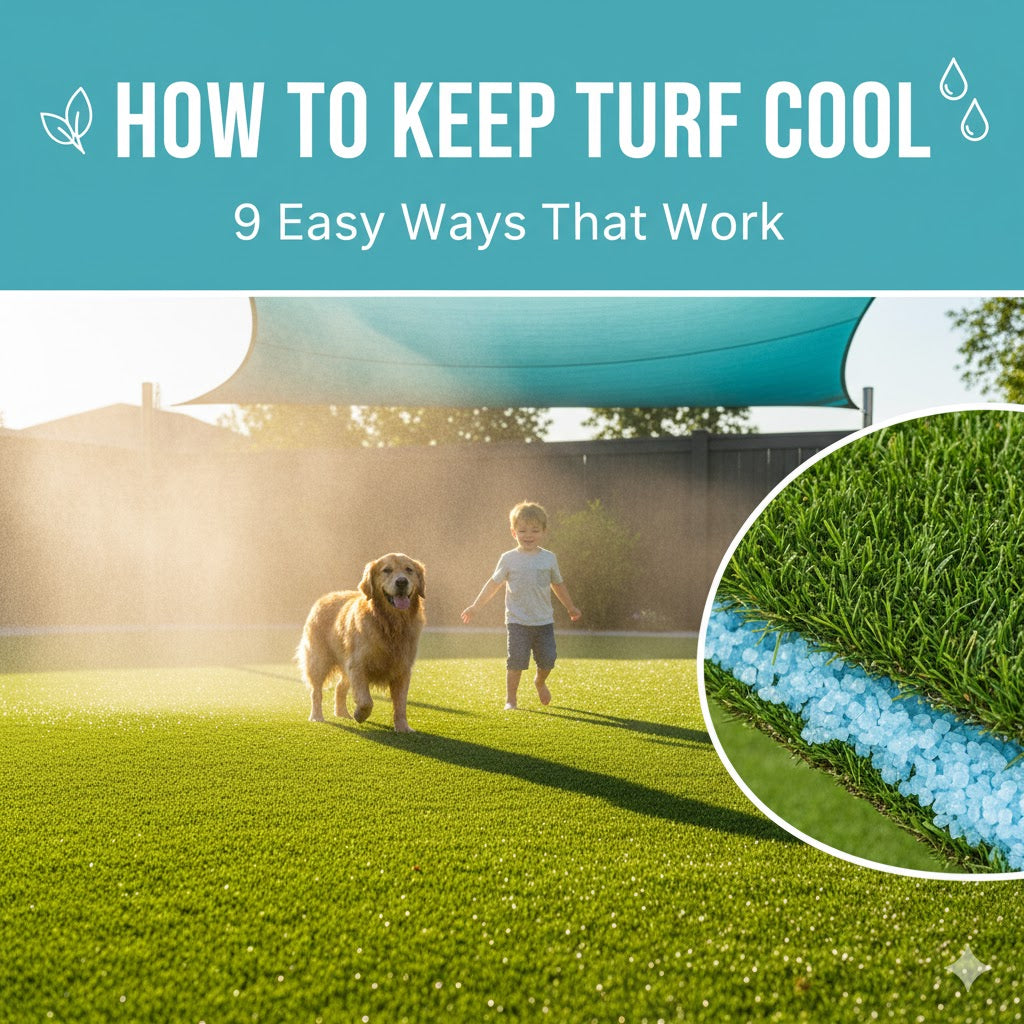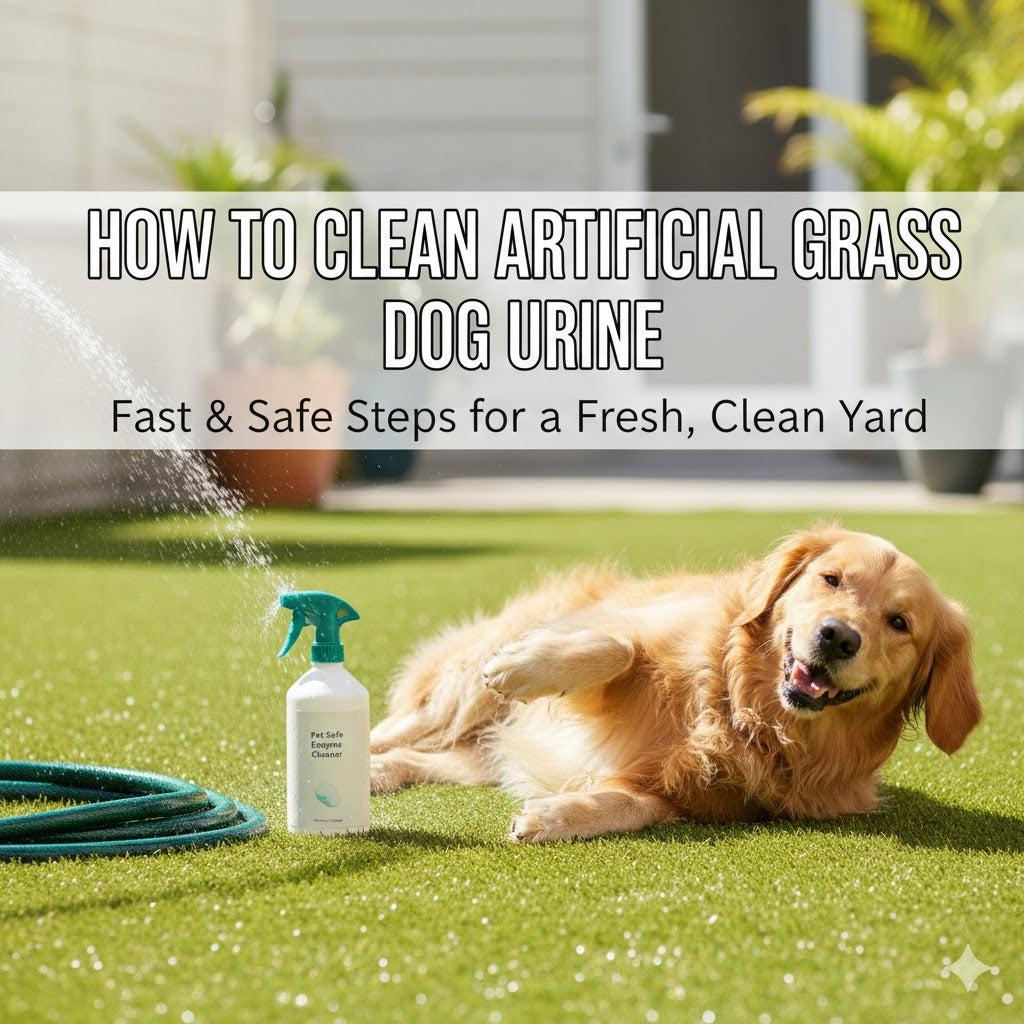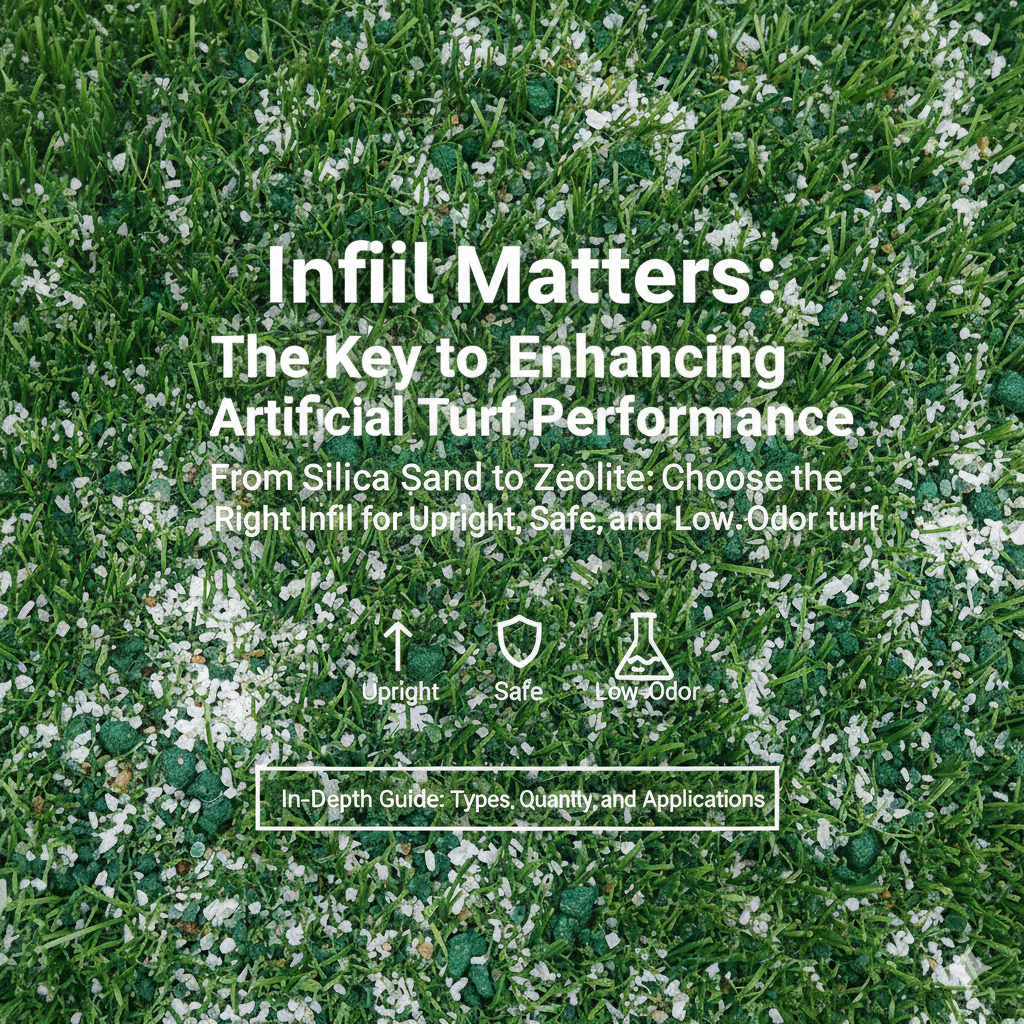Artificial turf has changed the way we design yards, sports fields, and play areas. It looks neat, needs less water, and is easy to care for. But one big problem is heat. Artificial grass can get very hot in the summer heat. High surface temperature makes it uncomfortable for athletes, kids, and pets.
If you want to enjoy synthetic grass without the heat, you need cooling solutions. In this guide, you’ll learn how to keep turf cool in 9 easy and proven ways.
Why Turf Gets Hot
Artificial turf and synthetic fibers absorb solar radiation. Unlike natural grass, it does not release water through evapotranspiration. This leads to heat retention. Darker artificial grass and crumb rubber infill trap more solar rays, making the field hotter. Some fields can reach over 150°F. That’s much hotter than natural grass.
The good news is that turf cooling systems, cooling infills, and shade structures can lower surface temperatures. Let’s look at practical ways you can use them.
1. Use Cooling Infills
One of the best answers to how to keep turf cool is to choose the right infill options. Infill is the material placed between synthetic fibers to support the turf. Traditional silica sand and crumb rubber trap heat. Cooling infills, like Hydrochill infill, walnut infill, or organic infill, work better.
Some of these materials hold water and provide evaporative cooling when the sun hits them. Others reflect solar rays instead of absorbing them. When paired with water application from a garden hose or irrigation systems, they can reduce heat buildup.
2. Pick Heat-Reflective Artificial Turfs
Fiber technology has advanced a lot. Many turf makers now use reflective yarns, FiberFresh technology, or Dual-Layered Fiber Construction to reduce heat retention. These artificial turf cooling systems reflect more sunlight and lower surface temperatures.
Brands like Lita Grass offer artificial grass infill materials and fibers that fight heat. Some products use Infrared-Reflective Technology or HeatBlock Technology to bounce back solar rays. These cooling systems work well for sports fields and recreation areas.
If you are planning artificial turf installation, ask your professional turf installer about these cooling technology options.
3. Install Shade Sails and Shade Structures
Shade is one of the simplest cooling solutions. Shade sails, sun sails, or shade cloths block solar radiation before it reaches the turf. Retractable shade systems or patio covers can work in backyards, turf yards, or pet runs. For sports fields, larger shade structures can cover sideline play areas or dugouts.
Pet owners can add small shade cloths or screening plants over pet turf. In a garden or recreation space, deciduous trees and drought-resistant varieties give natural shade. These changes protect outdoor surfaces and lower surface temperature.
4. Add Misting Systems
Misting systems are a quick turf cooling system. A light spray of water cools artificial turf right away. The drop in surface temperature can be large, but it only lasts about 20 minutes. For sports fields, misting systems or irrigation systems work well during breaks.
In a backyard or turf yard, you can use a simple garden hose. Spray the artificial lawn before pets or kids go out to play. It’s not a long-term solution, but it helps.

5. Improve Air Circulation
Good airflow helps reduce heat buildup. Open spaces allow hot air to move away from the turf surface. If your artificial lawn is near walls or fences, think about adding air gaps or low shade structures to promote circulation.
For sports fields, fans or blowers can support air movement in certain areas, like team benches. Air circulation will not cool synthetic turf as much as water or shade, but it helps lower surface temperature.
6. Use Water-Retaining Granules or Permeable Backing
Some artificial turf cooling systems include water-retaining granules under the turf. These store water after rainfall or water application. When the turf gets hot, the water slowly evaporates, creating evaporative cooling.
Permeable backing also helps with water management. It lets water move through the turf into the cooling layer below. These turf cooling systems reduce heat buildup and extend cooling after irrigation.
7. Choose Lighter Colors and UV Inhibitors
Darker artificial grass absorbs more heat. Choosing lighter shades of synthetic turf lowers surface temperature. Some turf products also use UV inhibitors in their fiber formula. These block solar rays and protect synthetic fibers from damage.
Heat-resistant turf with reflective yarns and special coatings is a smart choice for desert climates. This approach works best when combined with shade structures or cooling infills.
8. Plan Smart Turf Layouts
Where you install artificial turf matters. If possible, place turf away from large reflective surfaces like glass windows, metal fences, or walls. These surfaces bounce solar radiation back onto the turf and raise surface temperature.
For turf yards, adding Custom Park Surfacing like screening plants, sun sails, or patio covers can shield play areas. Pet runs and recreation areas also benefit from smart layout choices. These steps reduce heat buildup and improve heat management.
9. Schedule Play Smartly
Even with the best turf cooling systems, artificial grass can still get hot at mid-day. Sports fields and play areas should adjust schedules. Games, practices, or pet playtimes are better in the morning or evening.
Heat management policies like water breaks and use of misting systems during peak hours protect athletes and pet owners. Using FIFA Method 14 or ASTM F1505 test methods, field managers can check abrasive index, density of the grass, and heat buildup to ensure safe use.

Extra Tips for Different Users
Artificial turf is used in many ways, and each setting faces unique heat challenges. Pet owners, sports programs, and families with play areas all need tailored cooling solutions to make synthetic turf safe and comfortable.
For Pet Owners
Pet turf is popular because it is easy to clean and always looks neat. But it can heat up quickly under the sun, which may burn paws. To keep pets safe, add shade sails, patio covers, or shade cloths in pet runs or resting areas. A quick spray with a garden hose or a small misting system lowers the surface temperature before pets go outside. Choosing turf with cooling infills or permeable backing also helps, as these designs provide evaporative cooling and improve drainage. Pet owners should schedule play in the morning or evening, avoiding mid-day outdoor surfaces.
For Sports Fields
Sports fields built with synthetic turf face intense heat because of their size and exposure. The best defense is to install turf made with reflective yarns or advanced cooling systems, paired with infill options like Hydrochill or engineered silica sand alternatives. These materials reduce heat buildup and keep fields safer for athletes. Adding shade structures along sidelines or dugouts provides cooler rest zones. Coaches should also use irrigation systems, misting stations, and regular water breaks as part of overall heat management.
For Play Areas and Turf Yards
Children often play barefoot, so hot turf is a risk in play areas and turf yards. Select heat-reflective artificial turf with soft fibers and infills that stay cooler than crumb rubber. Add shade cloths, patio covers, or deciduous trees to block direct sun. Smart placement also reduces heat buildup and keeps play spaces comfortable.

Balancing Cooling and Water Conservation
Water is one of the fastest ways to reduce turf temperature. A quick spray from a garden hose or the use of misting systems can cool artificial grass right away. However, in a desert climate or any drought-prone region, relying on constant irrigation is not practical. This is where modern turf design and smart water management make a difference.
New turf systems use cooling infills, permeable backing, and water-retaining granules to stretch every drop of water. Cooling infills like Hydrochill or organic blends hold moisture and release it slowly through evaporative cooling when the turf heats up. This process can keep the surface comfortable for longer compared to plain watering. Permeable backing improves drainage, allowing water to pass through evenly and preventing puddles, while water-retaining layers store moisture for gradual release.
These features help achieve lower surface temperatures without wasting water. Homeowners, sports field managers, and pet owners can apply light irrigation only when needed, reducing overall use while still managing heat buildup. This approach supports both comfort and water conservation, which is especially valuable in dry regions where every gallon counts.
Final Thoughts
Artificial turf, synthetic turf, and synthetic grass are here to stay. They save water, reduce mowing, and keep yards looking good. But heat buildup is a real challenge.
By using cooling infills, shade sails, misting systems, and new cooling technology, you can lower surface temperatures and enjoy your turf year-round.
The steps above show you how to keep turf cool in simple and effective ways. Choose the right cooling solutions, plan for air circulation, and manage play schedules. These 9 methods will keep outdoor surfaces safer, cooler, and more fun for everyone.
If you are looking for reliable artificial turf that balances comfort, durability, and cooling solutions, LITA Grass offers many options for homes, play areas, and sports fields.



Leave a comment
This site is protected by hCaptcha and the hCaptcha Privacy Policy and Terms of Service apply.